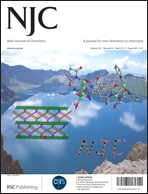Towards efficient polyoxometalate encapsulation in MIL-100(Cr): influence of synthesis conditions†
Abstract
The one-pot encapsulation of phosphotungstic acid in the metal–organic framework MIL-100(Cr) has been studied under different synthesis conditions. Both conventional and microwave heating methods have been explored for three different solvent systems: pure aqueous or organic (DMF) phase and biphasic mixtures (


 Please wait while we load your content...
Please wait while we load your content...